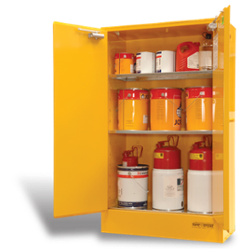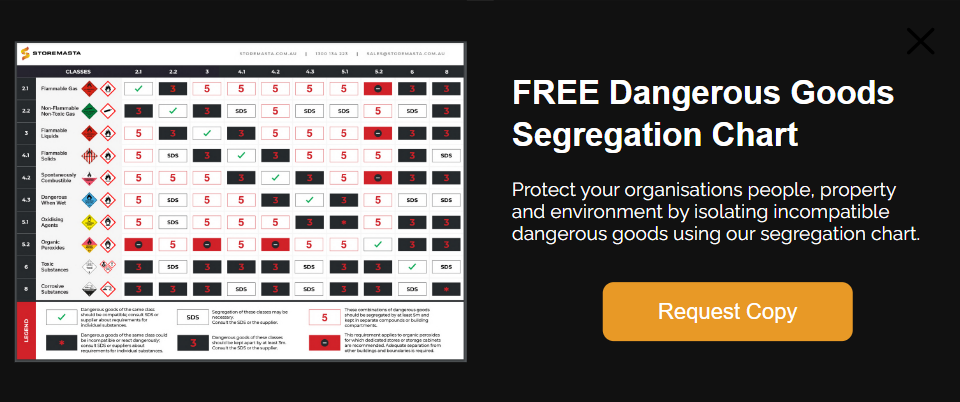If your workplace uses oxidising agents, such as hydrogen peroxide and potassium nitrate, it’s very important that you store and manage these substances in a way that reduces the risk that they pose to the people and property of your organisation. One key factor to consider when storing an oxidising agent, is to ensure that the chemical is kept well away from other incompatible classes of dangerous goods. There are many chemicals that are incompatible with oxidising substances — and there are other chemicals that will react dangerously with oxidisers.
To determine the segregation rules for oxidizing substances, you can refer to the Australian Standard AS/NZS 3833 – The storage and handling of mixed classes of dangerous goods, in packages and intermediate bulk containers.
We’ll look at these requirements in depth below, so you can understand the dangers associated with your oxidising agent – and what you can do to minimise risk. But first, let’s look at the difference between incompatible substances and those that can react dangerously.
Incompatible Substances and Substances that React Dangerously
Incompatible substances are defined as those dangerous substances that are:
- Likely to increase risk to people, property and the environment when mixed or brought into contact with another substance.
- Listed in the Australian Dangerous Goods Code or NZS 5433 as being incompatible.
- Declared by the local regulatory authority as being incompatible
- Substances that react dangerously
Substances that will react dangerously are those substances that react in a manner that directly creates a hazard due to the reaction:
- Being violent
- Producing an explosion
- Producing a potentially explosive combination of products
- Producing toxic vapours or gases; or
- Producing fire or rapid evolution of heat
Why are Oxidising Agents Dangerous?
An oxidising agent has the potential to contribute to the combustion of other materials. While not necessarily combustible within themselves, these substances may cause or contribute to the combustion of other materials due to their ability to yield oxygen. These substances are also harmful to human health, so the appropriate personal protective equipment must be used. Oxidising substances must not make contact with the skin or eyes, and great care should be taken to avoid the inhalation of vapours or dusts from oxidising agents.

Oxidising agents can contribute to the combustion of other materials, with these chemicals also negatively affecting human health.
Fire Risk with Oxidising Substances
Oxidising agents can yield oxygen through a chemical reaction. This can create a fire risk when both oxygen and a flammable fuel are mixed in the presence of an ignition source. In addition to the segregation requirements for oxidizing substances, the isolation of ignition sources and flammable materials is a necessary precaution for workplaces who use, generate, handle or store these Class 5.1 chemicals.
Dangerous Goods Segregation
To protect staff and property, oxidising substances must be segregated from dangerous goods that are incompatible and those that react dangerously.
The segregation of incompatible classes of dangerous goods can be achieved by using separate chemical storage cabinets or outdoor dangerous goods stores.
The storage and segregation of oxidising agents in the workplace may include the use of indoor Class 5.1 safety cabinets.
While it’s unadvisable, if you do need to store mixed classes of dangerous goods in a common dangerous goods store, the different classes of dangerous must be separated by specific distances. These segregation distances are predetermined by the Australian Standard AS 3833-2008 - The storage and handling of mixed classes of dangerous goods.
Why are Oxidizing Agents Usually Stored Away from Other Chemicals?
Oxidizing substances are a class of dangerous goods that requires careful chemical segregation practices. This is because these chemicals pose a severe risk, due to the various classes of dangerous goods that they can react dangerously with – or are incompatible with.
The required separation distance for oxidising agents from other incompatible dangerous goods depends on the compatibility of the chemicals.
Substances That React Dangerously With Oxidising Agents
There are many substances that will react dangerously with oxidising agents.
These substances fall under the dangerous goods classes outlined below:
- Class 2.1 - Flammable Gas
- Class 3 - Flammable Liquids
- Class 4.1 - Flammable solids
- Class 4.2 - Spontaneously Combustibles
- Class 5.2 Organic Peroxides
These chemicals must not be kept in a facility used to store oxidising agents if they cannot be safely segregated.
If your onsite substances fall under the dangerous goods classes outlined above, they can only be stored in a common storage facility with oxidizing substances if they’re separated by at least 5 metres. In addition to this requirement, the dangerous goods classes must be kept in different compounds with separate spill containment sumps.
Substances That are Incompatible with Oxidising Agents
The chemicals that are incompatible with oxidising agents are those substances that fall under the dangerous goods classes outlined below:
- Class 4.3 - Dangerous When Wet
- Class 6.1 - Toxic Substances
- Class 8 - Corrosive substances
Substances that are classified as either toxic, dangerous when wet or corrosive will not react dangerously with oxidising agents, but there is the possibility that they will pose further risks upon the people and property of your organisation if they are mixed. Storing these incompatible substances in a dangerous goods store containing oxidising agents must be avoided— at all times.
If oxidising agents must be stored with other incompatible substances in the same dangerous goods store, you are required to keep these incompatible substances apart by a distance of at least 3 metres.
IMPORTANT: If you’d like to learn more about the safe storage of oxidising agents, check out our blog that details the Ventilation Requirements for Oxidising Agent Storage Cabinets.
Substances That May Be Incompatible or React Dangerously
Some substances that share the same dangerous goods classification may be compatible with each other. This means that some classes of dangerous goods may be stored within the same store safely.
However, when it comes to Class 5.1 Oxidising Agents, this is not the case.
Some oxidising agents are incompatible with other Class 5.1 chemicals, with some substances even reacting dangerously if they’re kept or handled in the same area.
Before storing two different oxidising substances together, it’s crucial that you check the safety data sheets for each substance to determine their compatibility. If these substances are incompatible, they must be kept apart by at least 3 metres. If the two different substances will react dangerously, they must be segregated by at least 5 metres.
Get your FREE magnetic segregation chart
Substances That May Be Incompatible with Oxidising Agents
Generally speaking, Class 2.2 Non-Flammable Non-Toxic gases are compatible with most other classes of dangerous goods. However, some non-flammable non-toxic gases are incompatible with oxidising agents.
To ensure that you do not pose any further risk to the people or property of your organisation, it’s important that you check the compatibility of oxidising agents and non-flammable non-toxic gases before they are stored together.
If these substances are incompatible, they must be kept apart by at least 3 metres. The compatibility of these substances can be determined by consulting the safety data sheet for each substance.
Safe Segregation with Oxidising Substances in the Workplace
Oxidising agents are incompatible with many classes of dangerous goods – and may even be incompatible or react with chemicals within their own class. To avoid violent chemical reactions that could harm the people and property of your organisation, it’s vital that you have a disciplined approach to storing mixed classes of dangerous goods. If you’d like a Dangerous Goods Segregation Chart to help you identify which classes of dangerous goods are incompatible with oxidizing agents, you can access your own copy for FREE today.
Joining the team as a Dangerous Goods Storage Consultant, Melissa Hampton became Storemasta's Marketing Manager in late 2021. With extensive knowledge and experience in chemical compliance, Melissa is responsible for leading the Marketing team and helping shape their marketing strategy. In her spare time, you can find Melissa hiking, swimming and enjoying the great outdoors in beautiful north-west Tasmania.

